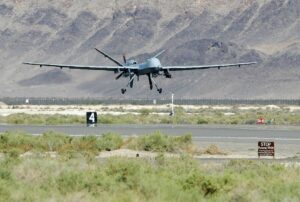China’s ubiquitous surveillance of its citizens is the type of intrusion into people’s daily lives that Americans have avoided, mostly. Yet closed-circuit television systems are already in stores, on street corners, in hospitals, and in a growing number of places Americans frequent. Airborne drones have become relatively commonplace within a short span of time. Coincidently, the development of facial recognition software is becoming more capable and precise. Marry improving facial recognition technology with the ever-increasing numbers and persistent presence of drones and American citizens have the potential for runaway surveillance mischief and breaches of personal security.
“The US Air Force has begun implementing facial recognition into its autonomous drones. The Air Force intends to use the technology for Intelligence gathering and as support in ‘other missions,’” Cal Jeffrey reported for Techspot. Those at the forefront of facial recognition software naturally promote the technology as a capability useful for good. When engaging in combat where the battlespace is confusing, knowing “who is who” can make the difference between destroying the enemy while keeping US forces from harm, and having a friendly fire incident. However, Jeffrey noted, “some fear the US could deploy drones for assassination and that even the most sophisticated systems still are not 100 percent accurate.”
Drones and Facial Recognition Software, a Troubling Combination
“The drone software maker, Seattle-based firm RealNetworks, claims the uncrewed craft will use artificial intelligence (AI) to fly itself and discriminate between friend and foe … [the] software can also be used for rescue missions, perimeter protection, and domestic search operations,” Sascha Brodsky explained in Popular Mechanics. However, it is a very slippery slope moving from using autonomous unmanned aerial vehicles (UAVs) for search and rescue to using UAVs for illicit surveillance of innocent Americans.
Using facial recognition software integrated with sophisticated intelligence, surveillance, and reconnaissance sensors on US military UAVs could take intrusion into Americans’ privacy to a whole new level. A year ago, in March 2022, the US Office of the Director of National Intelligence (ODNI) awarded multiple contracts to universities and commercial companies to look into “whole-body” biometric identification. The contracts continued ODNI’s Biometric Recognition and Identification at Altitude and Range (BRIAR) program. As an ODNI press release explained:
“The program’s advanced research and technologies will enable the Intelligence Community and Department of Defense to recognize or identify individuals under challenging conditions, such as from unmanned aerial vehicles (UAVs), at far distances, and through distortions caused by atmospheric turbulence.”
However, the press release did not discuss the operational process controls necessary to ensure the technology is focused on bad guys, not US citizens. In the hands of an unethical bureaucrat, the ability to identify a single individual from among hundreds in a crowd, or foot traffic on a city street, and track wherever the person goes is not comforting.
Tracking Technology Puts Responsibility on Decision-Makers

(Photo by Ethan Miller/Getty Images)
“The question here really is not so much around the use of technology to track an individual, but rather the decision-making process that lists them as a ‘person of note’ to track in the first place. Why are they being targeted? What evidence is there that they pose a potential threat?” Mike Ryder, an expert in robotics and artificial intelligence at Lancaster University in the UK, told Newsweek. The idea of dealing with a “potential” threat – before a crime or terrorist act takes place – quickly becomes the plot for a Minority Report II movie.
Identifying an individual from a high altitude through clouds using biometric AI algorithms is fascinating technology. For the US, helping to control the southern border would be a constructive use for UAVs with facial recognition capability. But like all high-tech breakthroughs, for all the positive attributes there may be, people will generally find a dark side to exploit. With high-altitude surveillance platforms able to use facial recognition technology, the opportunity for mischief is great. In China, citizens are monitored with closed-circuit television cameras, and Beijing already applies facial recognition to track its people. Responsible use of technology is the hallmark of a free society. The US intelligence and law enforcement communities need to keep that in mind.
The views expressed are those of the author and not of any other affiliation.
Do you have an opinion about this article? We’d love to hear it! If you send your comments to [email protected], we might even publish your edited remarks in our new feature, LN Readers Speak Out. Remember to include the title of the article along with your name, city, and state.
Please respect our republishing guidelines. Republication permission does not equal site endorsement. Click here.

